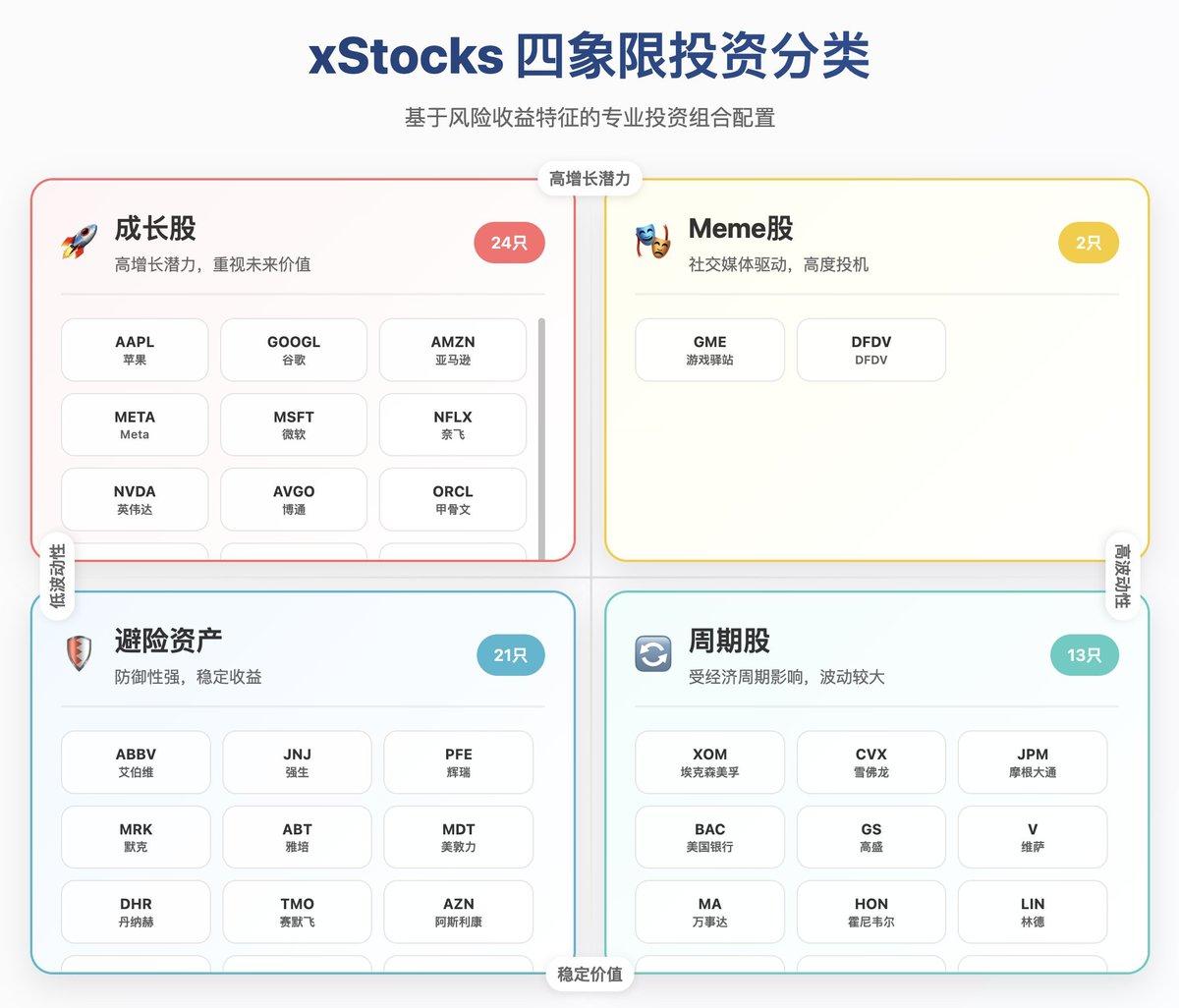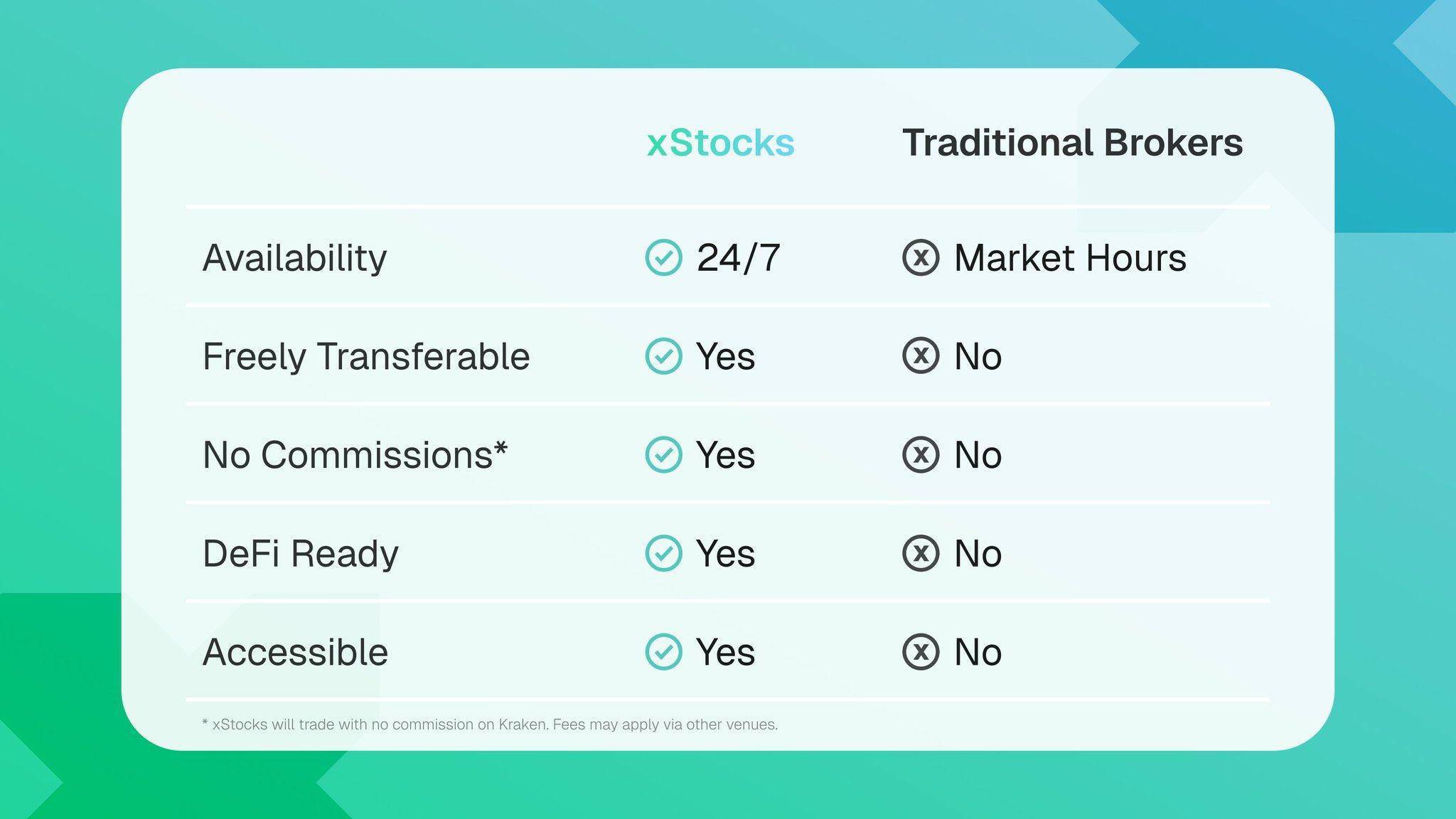Entering the second half of 2025, Web3 and traditional finance are accelerating their integration. A narrative around "U.S. stocks on-chain" is rapidly taking shape. Key participants are entering the scene, from CEXs, brokerages, and payment infrastructure to RWA-specific chains. This is not only a continuation of asset tokenization but also a reshaping of the underlying architecture of global capital markets.

📈 A Collective Action for On-Chain U.S. Stocks
1. Kraken / Bybit/Gate + xStocks
xStocks will custody over 50 U.S. stocks (such as Apple and Tesla) and mint them 1:1 as tokens on Solana.
Users can purchase directly with stablecoins on exchanges like Bybit / Kraken / Gate, including platforms that support xStocks trading like AiCoin, enabling borderless, round-the-clock asset allocation.
2. Robinhood's On-Chain Transformation
Over 200 stocks and ETFs, including Pre-IPO assets like SpaceX and OpenAI, have been deployed on the Arbitrum chain.
Developing its own L2 public chain, positioning itself as the main venue for trading stocks, bonds, and ETFs, aiming to define the issuance standards for stock tokens.
Bitstamp is responsible for order matching, providing 24/7 spot and perpetual trading services, especially targeting the European market.
3. Stripe's Stablecoin and Identity Layout
Acquired Bridge (stablecoin ↔ fiat conversion) and Privy (Web3 identity and self-custody wallet solutions).
Committed to lowering the entry barriers for merchants and users into on-chain finance, becoming an important payment bridge in the RWA ecosystem.
4. Plume and RWA-Specific Chain Projects
Plume is building infrastructure for the issuance and combination of RWAs such as insurance, bonds, and real estate.
Broker-dealer self-built chains like Robinhood Chain will create direct ecological competition with RWA projects.
✳️ Motivations for U.S. Stocks Moving to Crypto
**
- Insufficient Efficiency of Dollar Financial Infrastructure**
The fiat deposit process is complex, especially for non-U.S. users.
U.S. stocks are limited to trading on weekdays, with global liquidity constraints.
Crypto offers 24/7 borderless trading, extremely low costs, and a highly programmable trading framework.
- Stablecoins = New Dollars, Wallets = New Brokerages
Users can allocate U.S. stock assets using stablecoins, bypassing the banking system.
Wallets take on identity, investment, and payment functions, providing one-stop management of on-chain assets.
- On-Chain Need for Anchored Assets
U.S. stock tokens are the most liquid, easiest to regulate, and most recognized type of RWA.
They have a natural advantage as "DeFi collateral" compared to RWAs like real estate and notes.
🔍 The Relationship Between U.S. Stock Tokenization and RWA
Function
Description
Trust Anchored Assets
U.S. stocks have the highest level of global recognition, reducing user education and trust costs for RWAs.
Liquidity Seed Assets
AAPL and TSLA tokens can participate in lending, structured products, and collateral, far surpassing low liquidity assets.
Compliance Bridge
There are existing trust structures (like the xStocks model), making it easier to gain regulatory support.
⚖️ Impact Analysis of Platforms and Crypto Users
For Platforms (Robinhood, xStocks, CEX)
Advantages
Disadvantages
Strong user retention + diverse asset combinations
Custody mechanisms require 1:1 real correspondence, posing shadow asset risks.
Diverse revenue models
Policy gray areas are significant, and future compliance costs cannot be ignored.
Positioning for on-chain securities standards and RWA scenarios
System integration with off-chain markets is complex, with high development and maintenance costs.
For Users (Crypto Investors)
Benefits
Risks
Invest in U.S. stocks without opening an account, diversifying assets.
Risk of asset false anchoring or decoupling, potential FTX-like hazards.
Participate in on-chain U.S. stocks + DeFi combination strategies.
Certain regions have clear regulations prohibiting such securities token trading.
Round-the-clock trading with strong liquidity.
Lack of market-making may lead to severe pricing deviations from the real market.
🧩 The Ecological Competition Between Robinhood and xStocks
Project Party
Positioning
Technical Path
Advantages
Challenges
xStocks
Stock token issuance platform
Solana
Compliant custody structure is complete, with cooperation from multiple CEXs.
Non-closed-loop ecosystem, easily replaceable.
Robinhood
Brokerage + public chain issuer
Self-built L2 + Arbitrum
Has a complete closed loop of user system, matching, and issuance.
Compliance and technical difficulties are extremely high.
Stripe
Wallet + payment entry
Multi-chain integration
Has fiat bridge and user base.
Lacks trading scenarios.
Plume
RWA modular platform
Independent chain / modular combination
High integrability.
Insufficient user entry and liquidity.

🌍 New Narrative Window and Cyclical Opportunities
On-chain asset combinations will evolve from meme to real cash flow, attracting long-term capital.
On-chain issuance (like "legalized ICOs") may become mainstream, with project parties raising funds and stocks circulating on-chain simultaneously.
Investment logic will shift from narrative speculation to yield anchoring and dividend logic.
🔥 The Current Relationship Between the Dollar and Crypto
Dimension
Current Performance
Dollar Circulation Scenarios
Stablecoin trading volume has exploded, with Crypto wallets becoming the "global entry point" for dollars.
Dollar Issuance Channels
Circle, Tether, Stripe, Base, etc., are building a "de facto Federal Reserve" system.
Regulatory Perspective
Differentiated regulation: tightening on DeFi and anonymous coins, while RWA and stablecoins tend to be inclusive or guided.
Relationship Attribute
Crypto is the global proxy network for dollars on-chain, not an adversary, but an extension of the underlying infrastructure.

🔮 Future Trends: Can Tokenized Securities Truly Land?
Tokenized securities are currently in high demand, but whether they can truly land in compliance in the future still depends on two key factors: the certainty of policy release and the continuous optimization of market mechanisms.
🏛️ Regulatory Variables are Restructuring Industry Expectations
In recent years, regulation has been the biggest obstacle to the integration of the crypto world and traditional securities, but this wall is beginning to loosen. The policy direction in the U.S. is one of the focal points to observe. If Trump is re-elected in the upcoming elections, the new government is expected to bring more lenient and pragmatic crypto policies. There are already many signs indicating a more relaxed regulatory atmosphere:
The SEC has withdrawn some lawsuits against mainstream trading platforms like Coinbase and Kraken;
A special regulatory working group for digital assets has been established to reshape the compliance path for the industry;
Significant breakthroughs in stablecoin legislation have injected a compliance foundation for on-chain dollars;
Several SEC executives have stated that "tokenized financial instruments are not inherently securities."
At the same time, Europe's MiCA regulations, as well as digital securities regulatory systems in Japan and Singapore, are also taking shape. Switzerland's DLT law and MAS-authorized RMO licenses provide a legal and compliant operational soil for platforms like Backed. This means that major global jurisdictions are signaling "compliance pilot" for tokenized securities.
🧠 Evolution of Technology and Market: From "Concept Products" to "Actual Experience"
Compared to the previous cycle, the product design of this round of tokenized securities projects has significantly improved. They pay more attention to the authenticity of underlying assets and on-chain verifiability. For example:
Backed and Swarm provide monthly reserve reports;
Oracles like Chainlink synchronize token prices with corresponding assets in real-time;
Platforms like Robinhood and Bybit directly embed tokenized U.S. stocks into their existing trading platforms, enhancing the interactive experience.
Additionally, new mechanisms such as T+0 settlement, fractional share purchases, and round-the-clock trading allow users to allocate U.S. stock assets like Apple, Nvidia, and Microsoft on platforms like AiCoin with low barriers and no intermediaries—trading experiences that may even surpass traditional brokerages.
❗ Three Core Challenges: From Liquidity, Regulation to Product Matching
Despite the increasingly完善 infrastructure, tokenized securities still need to address the following three major challenges to truly enter the mainstream:
Liquidity Bottleneck
Most tokenized stocks are still limited to trading within platforms (like xStocks), lacking cross-platform circulation and arbitrage channels, leading to low price discovery efficiency. The participation of market makers remains limited, especially in the absence of risk hedging and on-chain settlement mechanisms.Unclear Legal Definitions
In the U.S., whether "tokens equal securities" remains in a gray area. Unlicensed platforms offering U.S. stock tokenization services to American retail investors face severe legal challenges. In strictly regulated regions like China, extra caution is needed to avoid crossing the boundary of "illegal securities intermediaries."Differences in User Mindset and Financial Culture
For crypto users accustomed to high volatility, the yield fluctuations of U.S. stocks are relatively mild; convincing them to allocate part of their assets to stable-return tokenized stocks requires more financial education and yield scenario design.
🛠️ Possible Solutions and Innovative Paths
If the industry is to break through the current bottlenecks, it may need to innovate from the following dimensions:
Create a new tokenized shareholder experience through equity splitting or on-chain DAO co-ownership mechanisms;
Introduce a hybrid model of on-chain AMM + order book to address some liquidity issues;
Promote the establishment of unified regulatory standards for "tokenized securities" to enhance legal certainty;
Lower KYC thresholds to improve accessibility for crypto users (e.g., using on-chain credit scores to replace traditional identity verification);
Establish stable asset bridges, such as AiCoin working to enable bidirectional allocation capabilities between xStocks U.S. stocks and native crypto assets, reducing the cross-border trading barriers for retail users.
📌 Next Steps: Who Will Break the Balance First?
Whoever can first connect the entire process of "on-chain issuance of traditional assets → liquidity enhancement → compliance arbitrage" will define the underlying structure of the new generation of capital markets. This competition is still in its early stages, but the direction is clear:
RWA is the engine at the asset level;
Stablecoins are the "highway" for trading;
Compliance platforms like AiCoin, Bybit, and Robinhood are the entry points for traffic and trading efficiency.
If this system ultimately matures, tokenized U.S. stocks will not only become the anchor point of the RWA track but will also make the "on-chain migration" of capital markets more than just a narrative, but a true reality.
免责声明:本文章仅代表作者个人观点,不代表本平台的立场和观点。本文章仅供信息分享,不构成对任何人的任何投资建议。用户与作者之间的任何争议,与本平台无关。如网页中刊载的文章或图片涉及侵权,请提供相关的权利证明和身份证明发送邮件到support@aicoin.com,本平台相关工作人员将会进行核查。




